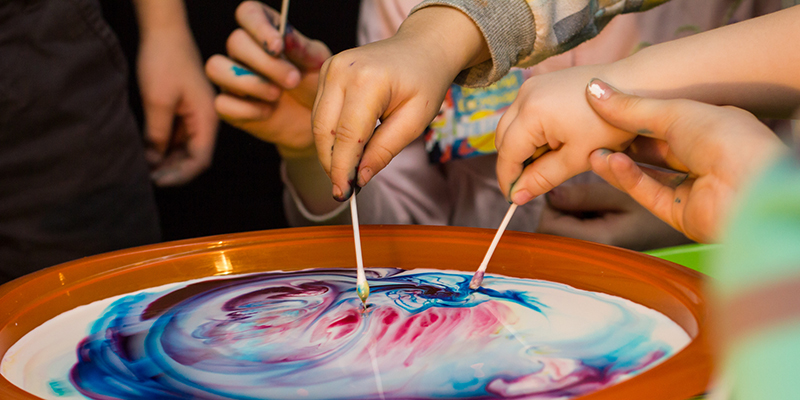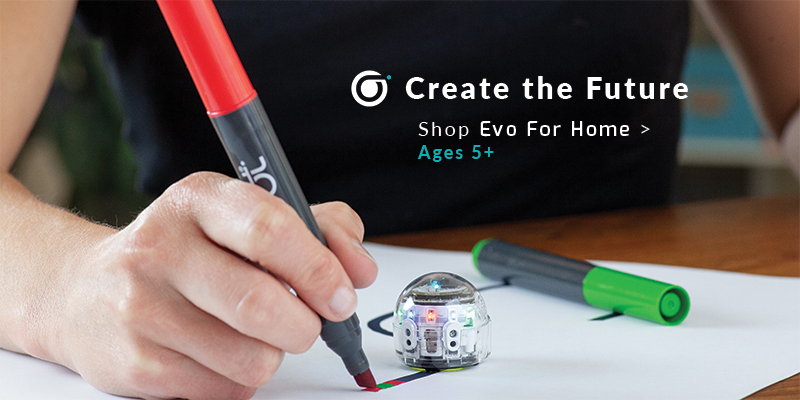—–Updated for 2020—– Many educators and newly-minted “homeschool teachers” have been reaching out for at-home activities to engage young minds in STEAM (Science, Tech, Engineering, Art, and Math). These are tough times. And we want to help. In addition to the 8 DIY Science activities below, check out these resources for STEAM while social distancing. If there’s more we can do, just let us know in the comments below!
Just For Educators
For Everyone
- Find FREE remote learning games (Coding and Math skills!) >
- Check out this awesome science lesson Megan and Caitlin completed with Evo while learning at home 🤯:
—————————————————–
Science is probably the most magical school subject out there. I was always so fascinated by science as a kid, and it was my favorite subject for a long time. We all remember those erupting volcanoes we made in grade school, right? Think about how enjoyable it was to watch as the vinegar was poured in. It seemed like magic watching the red eruption come up and over that papier-mâché mound.
Now that I am grown and have kids of my own, I want to reminisce that magical feeling and share it with them. So, I decided to test out some of the most fun (and easy) science experiments I could find!
At Ozobot, we explore the creative side of coding and make it easy for all ages with two ways to code: on screens with block-based coding and screen-free with colors. Taking that as my inspiration, I zeroed in on some science experiments that 1) mostly only require things that are already in your home, and 2) show off the creative side of science. Enjoy!
1. Jumbo Bubbles
What you’ll need:
- Water
- Dish soap
- Corn syrup
- Wire (think wire hanger or floral wire)
- Measuring cup
- Large bowl (or in my case, I used a large Tupperware)
In a large bowl, combine 1 cup of dish soap with 3 cups of water and ½ cup of corn syrup. Stir well.
Using your wire, shape it into a “bubble wand.” You’ll probably need to bend the handle so that the round part will fit nicely in the bowl.
Blow some bubbles!
We took this experiment over to a play date at my friend’s house. The kids absolutely LOVED it. Who doesn’t love giant bubbles? To be honest, the adults were really enjoying it as well. We definitely made sure that we got our turns in, too.
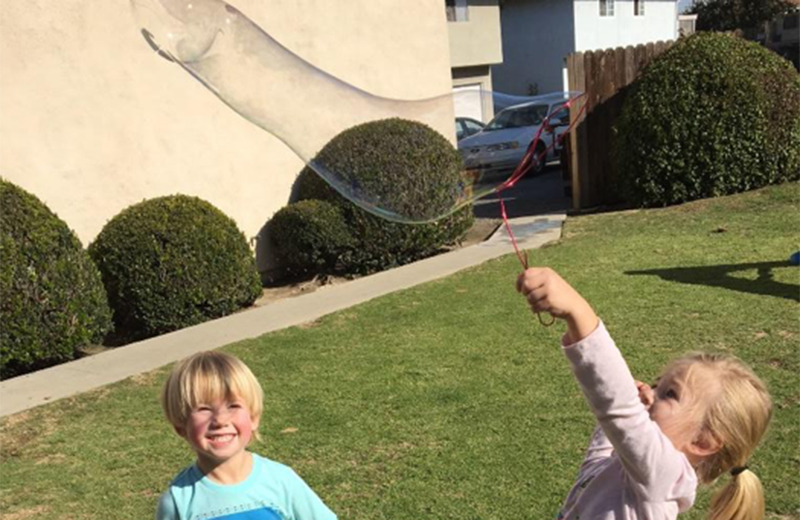
The bubbles were super easy to “blow.” All the kids had to do was lift the wand out of the solution and the wind did the rest. This also kept them entertained for a while!
The science behind it:
A bubble is, essentially, just air wrapped up in soap film. This soap film is made up of a thin layer of water sandwiched between two layers of soap molecules. When this film contacts air, it then forms a bubble.
2. Color-Changing Flowers
What you’ll need:
- White flowers
- Vase, or other receptacle to hold the flowers
- Water
- Food coloring
Start by filling your vases (one for each flower stem) most of the way with water. I just used empty salt and pepper shakers that were lying around my house.
Next, add your food coloring. You’ll want to put about 10 drops of color in each vase. My daughter is only three years old, so she had a bit of a hard time pinching the food coloring container. This is where your assistance may need to come into play, if you have younger children.
Place a single flower in each of your color-filled vases and set them somewhere they will be exposed to indirect sunlight.
Then you wait…
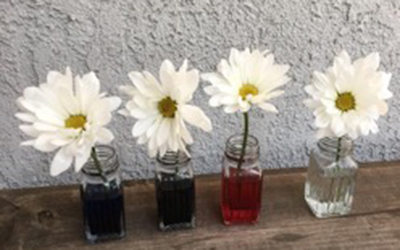
We expected this process to take a few days or so, so when we went outside to play and looked at our flowers, we were surprised to see the blue color had already started to show!
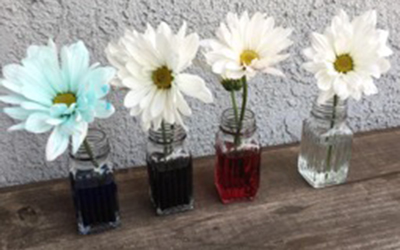
After 24 hours, this was what our flowers looked like:
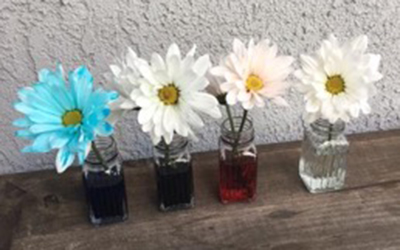
And after 48 hours:
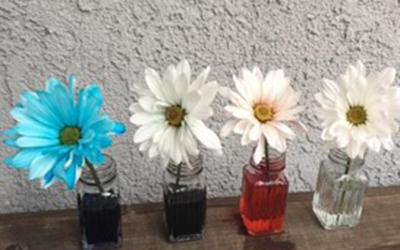
My daughter loved checking up on her flowers throughout the day. Every time, she would mention how the blue was so bright and would ask why the others weren’t absorbing as fast. The perfect science question! Why was the blue dye so quick to transfer to the flower, whereas the pink was slower and the purple hardly showed at all?
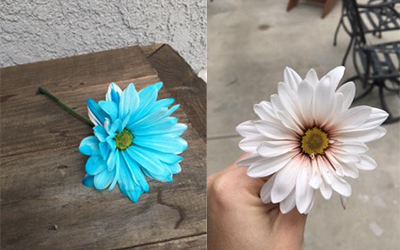
The science behind it:
Most plants “drink” water from the ground through their roots. The water travels up the stem of the plant into the leaves and flowers. The plant uses the water to make food.
When a flower is cut, it no longer has its roots. But the stem of the flower still “drinks” up the water and provides it to the leaves and flowers. So, when you add food coloring to the water, the petals absorb that color.
3. Homemade Rock Candy
What you’ll need:
- Sugar
- Water
- Skewers/candy sticks
- Glass jar(s)
- Large saucepan
- Clothespins
- OPTIONAL: Kool-Aid Packet(s) OR food coloring
Start by combining equal parts of water and sugar in the saucepan. The amount will depend on how many different flavors/colors of rock candy you’d like to make. The only important factor is that your sugar to water ratio is 3:1. Anything less than that, and the crystals won’t form.
We decided to do four different flavors. So, I started by heating up 4 cups of water and 4 cups of sugar in the saucepan.
Once the sugar is dissolved, slowly add more sugar until it will no longer dissolve. We added in another 8 cups of sugar. You want the water to have a “cloudy” look. This means you’ve reached the perfect sugar saturation. Remove from heat.
Let the sugar solution cool down about 30 minutes.
While the solution is cooling, dip your sticks into the sugar saturated water and roll around in sugar until thoroughly coated. Set aside and let them dry completely.
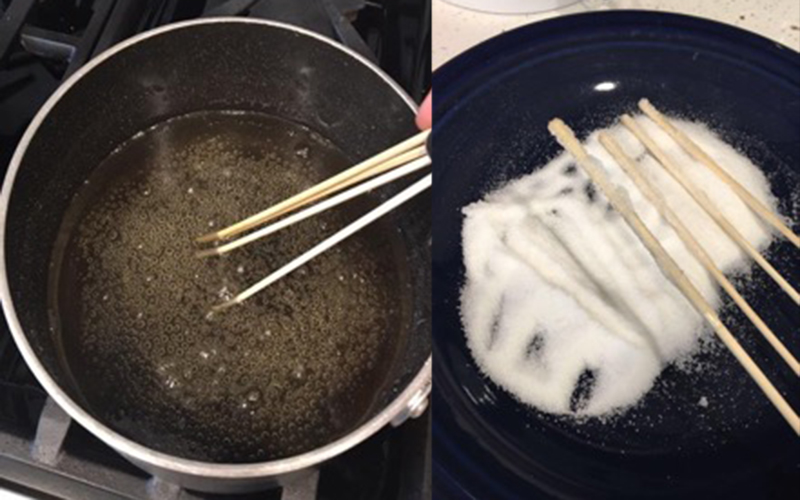
While you wait for the sticks and sugar water to finish cooling, add your packet(s) of Kool-Aid OR a few drops of food coloring into the bottom of your jar(s).
Once the water is cooled, pour into your jar(s). Give it a quick stir to distribute the Kool-Aid powder.
Dip your sticks into the jars and keep them held up by using a clothespin on the top.
Set your jar(s) aside and be patient…
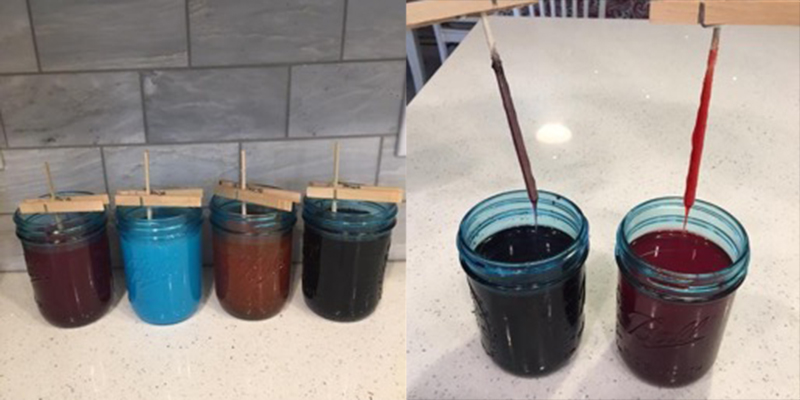
Okay, let’s talk about my total rock candy FAIL. Somehow, I didn’t get the solution right the first time I tried this experiment. Also, the Kool-Aid packets made it hard for us to see the crystals form (or NOT form, in our case). After two days, I decided to pull the sticks out to take a look and this is what I saw:
What on earth is THAT? Definitely not crystals. Just a thick sludge of sugary mess. I am unsure if I didn’t have the right sugar-to-water ratio or if it was the Kool-Aid packets that I used, but either way it was a fail. I went back to the instructions and just used food coloring this time.
We liked using the food coloring better because we could see things more clearly than the Kool-Aid. It also seemed like I got the sugar mixture right this time, thank goodness! So, we waited to see our final results.
The crystals started to form pretty quickly, this is what ours looked like on day 3:
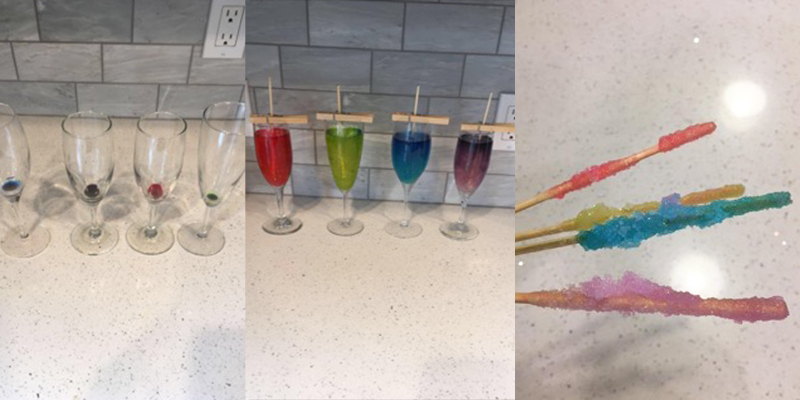
We were happy with our results from the second mixture! The crystals would have been larger if we had a wider glass. So, I recommend mason jars over champagne flutes for bigger, more impressive rock candy. Also, because the champagne flutes were small, the crystals got stuck to the glass. This made taking them out very difficult and partly the reason our candy is so sparse on the stick (you can really see this on the red stick).
Although they did not look very impressive, crystals still formed and they still tasted like rock candy!
Now comes the fun part, eating them! Not all at once of course… which my daughter wasn’t too happy about.
The science behind it: There are two different methods that contribute to the crystal growth. You created a supersaturated solution by first heating a saturated sugar solution then allowing it to cool. The supersaturated solution cannot stay in liquid form because it has too much solute (sugar) so the sugar will come out. This is called precipitation.
The other method is evaporation. As the water evaporates, the solution becomes more saturated and sugar molecules will continue to come out of the solution and collect on the seed crystals on the stick. The rock candy crystals grow molecule by molecule.
4. Color-Changing Milk
What you’ll need:
- Milk
- Dish Soap
- Shallow bowl
- Q-Tips
- Food coloring
Start by pouring milk into a shallow bowl (we used a pie dish) so that it only covers the bottom. There’s no need to use a ton of milk here.
In a separate small bowl, pour a little bit of dish soap.
Drop little bits of food coloring in the milk bowl, but do not overdo it. You want them to be a little spaced out.
Dip a Q-Tip in the dish soap and then place in the middle of your milk bowl and watch the colors start to move around!
This was probably the easiest experiment that we tried out. It was really fascinating to watch the colors all dance around and create a tie-dye art of milk at the end. It was also neat to see new colors form as some of the other colors mixed together.
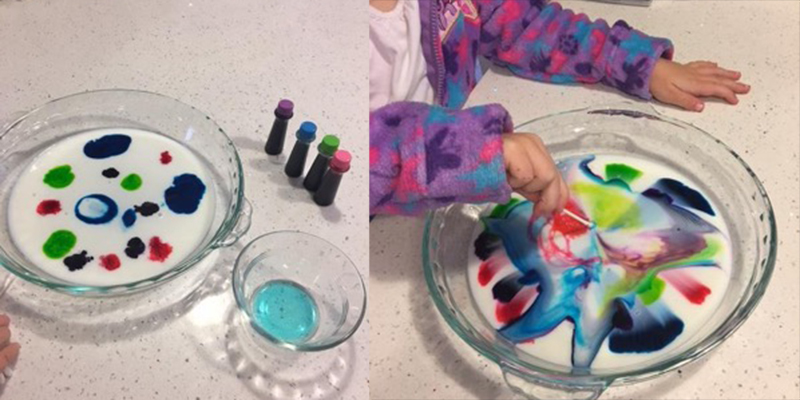
The science behind it: Per Steve Spangler Science, milk is mostly water but also contains vitamins, minerals, proteins, and tiny droplets of fat suspended in solution. Fats and proteins are sensitive to changes in the surrounding solution (the milk).
The secret of the bursting colors is in the chemistry of that tiny drop of soap. Like other oils, milk fat is a non-polar molecule and that means it doesn’t dissolve in water. When soap is mixed in, however, the non-polar (hydrophobic) portion of micelles (molecular soap structures in solution) break up and collect the non-polar fat molecules. Then the polar surface of the micelle (hydrophilic) connects to a polar water molecule with the fat held inside the soap micelle. Thanks to the soap connection, literally, the non-polar fat can then be carried by the polar water.
5. Skittles Rainbow
What you’ll need:
- Bag of Skittles candies
- 5 small glasses
- Hot water
- Tablespoon
- Syringe or pipette
Start by heating up some water so that it is hot, but not scalding. I microwaved mine for 1 minute.
Next, open your bag of Skittles and sort them by color. You’ll want to make sure that you have different amounts of each color. For example, we had:
- 10 red
- 8 yellow
- 6 orange
- 4 green
- 2 purple
Add two tablespoons of hot water into each of your small jars, then drop the colored Skittles into each jar.
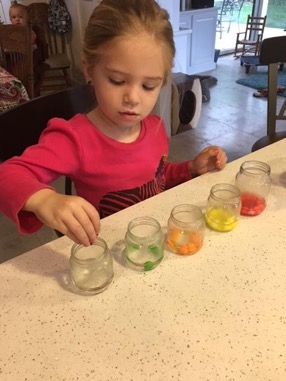
Once the candy dissolves (which should happen quickly), let the water cool to room temperature. If your candy doesn’t dissolve after stirring, try putting the jar in the microwave for 30 seconds.
While the water is cooling, this is the perfect opportunity to ask your child about their hypothesis. I asked my daughter which jar had the most candies in it (therefore, the most sugar. She is only 3, so I need to put the science talk into toddler words). She said orange had the most candy (again, she is 3.. but she’s learning!)
Once the water is at room temperature, pour each colored jar into a separate jar using a pipette or syringe. Start with the color that is the most dense (has the most candies in it) and end with the least dense.
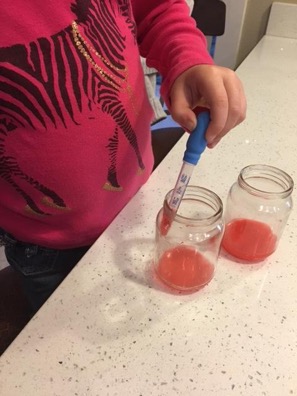
It is important to use the syringe or pipette and slowly dribble the water down the side of the jar. If you just pour the water in, you’ll end up with a jar of brown water. Also, make sure not to do it TOO slow, it’ll start to lose its brightness if you take too long.
My daughter has a short attention span, so she wasn’t thrilled that we couldn’t just pour the water in. I ended up doing the rest myself, but she loved the rainbow that we made at the end!
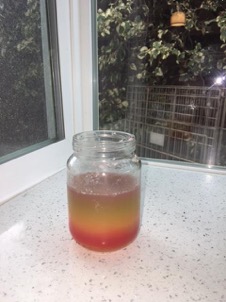
The science behind it: Each glass had the same amount of water, but different amounts of sugar. Because of this, the solution has a layering effect going from least dense (purple) to most dense (red).
6. Color-Changing Squirty Chalk
What you’ll need:
- 6 squirt bottles
- Food coloring
- Baking soda
- Vinegar
- Corn starch
- Funnel (if needed)
Start by filling 3 of your squirt bottles 2/3 of the way with equal parts corn starch and baking soda. I would recommend using a funnel if your squirt bottles had small openings, like mine did.
This takes a little bit of time, so do not get your child all excited about squirty chalk just yet. I made this mistake and the entire time I was trying to fill up my bottles, my daughter kept nagging me about it. It just makes for a more peaceful preparation if you refrain. Just my personal experience!
Once you are done with the baking soda and corn starch mixture, add a couple drops of food coloring in each one. You’ll want one red, one yellow and one blue.
Fill the rest up with water and use a butter knife to mix well. Once mixed, you’ll want to shake them well.
Set those aside and fill the remaining 3 bottles with vinegar. Add some red, blue and yellow food coloring to each one just like with the first 3 bottles.
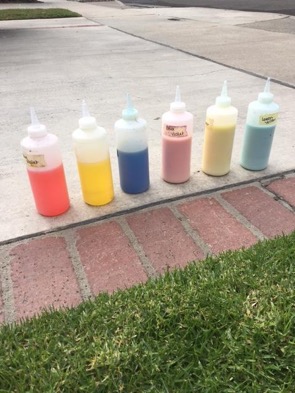
Go outside and have fun!
This one was super fun! We squirted the chalk onto the sidewalk and then squirted the vinegar ones on top and it fizzed and changed color! My daughter had a blast watching it happen. She actually preferred to be the vinegar squirter. I think she liked being the one in charge of the reaction.
We even made a heart!
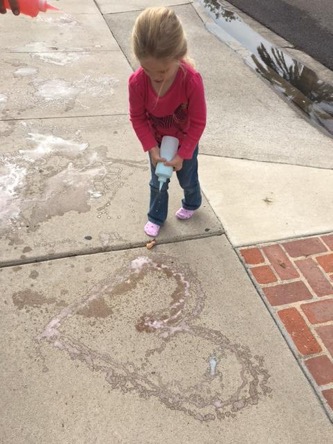
The science behind it: Baking soda and vinegar react with each other because of an acid-base reaction. Baking soda is a bicarbonate and vinegar is an acetic acid. Therefore, the reaction this creates is carbon-dioxide. So, when we add the colored vinegar to the colored chalk, the mixture makes that cool fizzing reaction. The colors change due to adding two colors together to make another color.
7. “Fishing” for Ice
What you’ll need:
- Water
- Salt
- Drinking glass
- Food coloring (optional)
- Piece of string
- Ice cubes
Fill up your drinking glass most of the way with water.
In a separate small bowl, combine salt with a couple drops of food coloring (this just made it easier to see the salt once you put it in the water).
Add a few ice cubes to your glass and place the string inside.
Sprinkle salt over the ice cubes, wait a minute or so and then pull out the string and see what you caught!
This one took several attempts before we could “catch” some cubes. My daughter kept pulling it out too fast and the ice would fall off the string. I recommend slowly pulling it out straight up. This was the best method that we found.
She was pretty excited to “fish” for the ice cubes! She thought it was really cool that the cubes stuck to the string like they did! I am also glad that we used the food coloring. I was able to show her where the ice was and explain to her why the cubes stuck to the string.
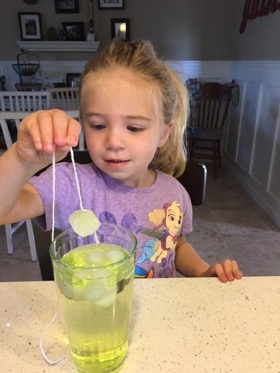
The science behind it: When salt is sprinkled over ice it melts. However, when it is used in such a small amount, like in this experiment, the water around the ice freezes again quickly. This means that the string gets trapped as the water around it refreezes, thus making it stick to the ice.
8. Glitter Explosion
What you’ll need:
- Vase
- Baking soda
- Vinegar
- Food coloring
- Glitter
- Pan to contain the mess
Place 2-3 tablespoons of baking soda in the vase. Put the vase in the pan.
Next, add in 6-7 drops of food coloring and 1-2 teaspoons of glitter.
Quickly pour in ½ cup of vinegar and watch it explode!
The science behind it: Baking soda acts as the base while vinegar is an acid and mixing the two together makes a reaction (explosion!).
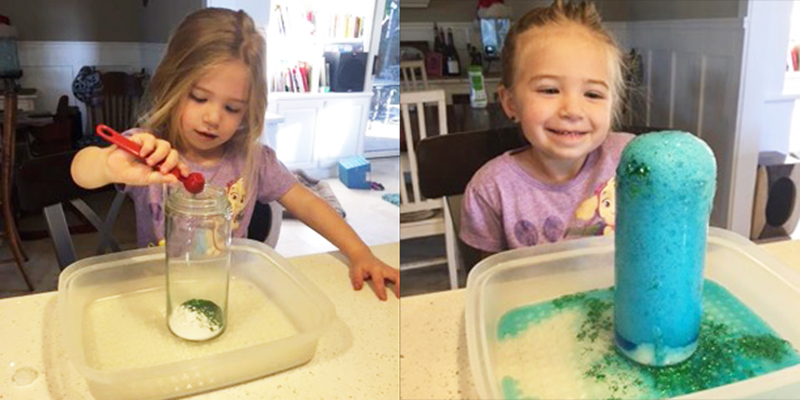
All that talk in the beginning of this post about the volcano experiments in grade school made me want to do something similar with my daughter! Of course, I had to add a baking soda/vinegar reaction type of science experiment to our list because they’re the most fun! Who doesn’t love watching things explode? Especially kids!
She kept wanting to add vinegar to make it explode again and the glitter made it pretty!
There you have it! All of these experiments were personally tested and given the seal of approval by me. I am no scientist BUT I am a mom who wants to get my kids interested in STEM early on and I feel like these are a great gateway to doing so. Try them out with your kids and send us your photos and experiences!
For even more engaging educational activities your kids can do at home, Ozobot Evo has activities for Science, Technology, Engineering, and Math, all with one little bot!


